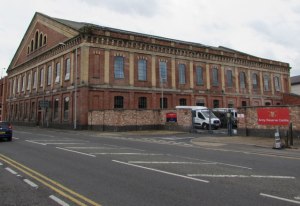Beaufoy & Co was the largest vinegar brewer in Britain.
Mark Beaufoy establishes the business
Mark Beaufoy (1719 – 1782) was the son of a Quaker maltster from Evesham, Worcestershire. The Beaufoy family claimed Huguenot ancestry.
Mark Beaufoy was apprenticed to a gin distiller in Bristol. A guilty conscience ultimately convinced him to leave the business, and he re-trained in vinegar brewing in the Netherlands.

Beaufoy leased a vinegar brewery on the site of Cupar’s Gardens at Strand Bridge, London from 1740. The brewery itself had been established in 1730.
In an age before refrigeration, vinegar was a much more important commodity than it is today, due to its preservative effect on foodstuffs. Beaufoy soon secured contracts to supply the Admiralty with vinegar.
The Dutch vinegar brewers used the waste from their indigenous raisin wine industry to filter and flavour their vinegar. No such industry existed in Britain, so Beaufoy was forced to buy raisins in order to maintain true to the method. He steeped the raisins to extract their sugar and mucilage, and then used the remaining solids in vinegar manufacture.
After Dr John Fothergill (1712 – 1780), a Quaker physician, suggested that Beaufoy might make raisin wine with this juice, he became a leading producer of “British wine”.
Mark Beaufoy died in 1782. His brother, John Hanbury Beaufoy (1761 – 1836), took over management of the business. John H Beaufoy was a cultured and erudite man.
Henry Beaufoy era
Henry Benjamin Hanbury Beaufoy (1786 – 1851) became senior partner in the business when he came of age.
Beaufoy & Co was one of the largest manufacturers in Lambeth by 1810.

The Beaufoy & Co site was subject to compulsory purchase for £34,705 in order to build Waterloo Bridge in 1812.
The brewery was relocated to Caron Place on the South Lambeth Road. The site was chosen as it was the closest place with a plot of land large enough to accommodate the works.
Beaufoy & Co was the largest brewer of vinegar in Britain by 1832, with 15 percent of the market in Britain and Ireland.
Beaufoy & Co was the fourth largest producer of vinegar in Britain in 1844.
H B H Beaufoy developed one of the finest private libraries in England. A Shakespeare First Folio was acquired in 1851.
H B H Beaufoy was a charitable man; he founded six scholarships at the City of London School, at a cost of £10,000, and spent £14,000 to build a ragged school (school for the poor) in Lambeth in 1851.
H B H Beaufoy died in 1851, and his brother Colonel George Beaufoy (1796 – 1864) took over management of the vinegar brewery. By this time the Caron Place site occupied over ten acres.
Colonel George Beaufoy enjoyed an annual income of around £6,000 by 1852.
Mark Hanbury Beaufoy
Colonel George Beaufoy died in 1864 and left a personal estate valued at under £250,000.
Ownership of the brewery passed to his only son, Mark Hanbury Beaufoy (1854 – 1922), for whom it was placed in trust and managed by his uncle until he came of age.
Dr Samuel Johnson’s armchair was acquired for the library in 1859.
Owing to public preference for a darker vinegar, caramel was added to the product by 1865.
Mark H Beaufoy was a cultured and genial man. He soon effected changes after he took over the business. He scrapped overtime, which had resulted in poor quality control from overworked employees. Beaufoy increased employee wages in order to compensate for the loss of overtime earnings. He argued, “all the work I now paid was for good work; previously a large percentage of it was bad work”.
The business employed 125 men in 1881.
M H Beaufoy introduced the eight hour working day for his workforce from 1889. With a half day on Saturday, this created a 45 hour working week. The change was regarded as successful, and Beaufoy was well-regarded by his workforce.
Vinegar production amounted to 790,096 gallons in 1898.*
Pott & Co, vinegar brewer of Southwark, was acquired in 1902.
The library was relocated to the family country residence at Coombe House, Wiltshire, from 1909. Some of the library contents were auctioned off. The Shakespeare First Folio was auctioned off in 1912.
Mergers and consolidation
Beaufoy was the oldest surviving manufacturer of vinegar in Britain by 1919.
Mark Hanbury Beaufoy died in 1922, and left a net personalty of £54,474.
The vinegar industry suffered from falling prices and decreasing demand in the post-war period. Consolidation seemed a reasonable defensive measure.
Beaufoy & Co merged with Grimble & Co to form Beaufoy Grimble, a public company with a capital of £160,000 in 1928. The head office was at Caron Place, South Lambeth. George Maurice Beaufoy (1893 – 1941) was appointed managing director.
Crosse & Blackwell merged their vinegar interests, including Champion & Slee and Sarson, with Beaufoy Grimble and Distillers to form British Vinegars in 1932. Beaufoy Grimble held a 21 percent stake in the venture, and G M Beaufoy became chairman of British Vinegars.
George Maurice Beaufoy was killed in the Blitz in 1941. He left a net estate of £19,678. Beaufoy, who had married in 1940, had no children, and his only brother had died in 1925. His death ended the Beaufoy family association with vinegar.
Beaufoy Grimble & Co was based at Leith, Scotland by 1954.
The Beaufoy vinegar brand was phased out after around 1961.
The Beaufoy site was closed in the 1970s. The brewery building still stands, and has been converted into housing.
The Scottish business was closed in 1983, and all production transferred to British Vinegars plants in England.
Beaufoy Grimble was voluntarily wound-up in 1986.
Source
* ‘Beaufoys of Lambeth’, David Thomas and Hugh Marks, Greater London Industrial Archaeological Society (2014).








